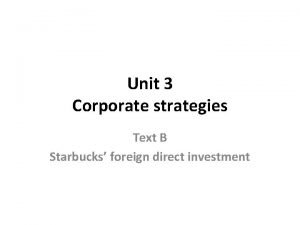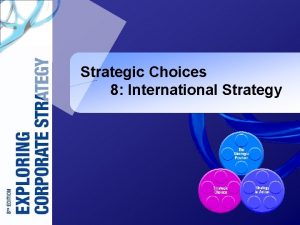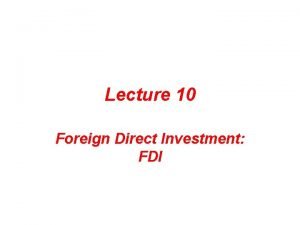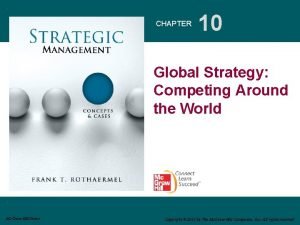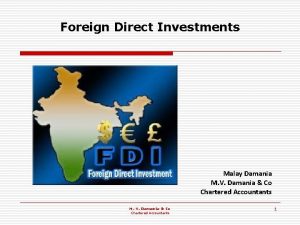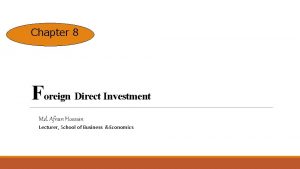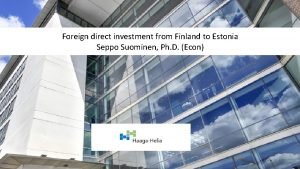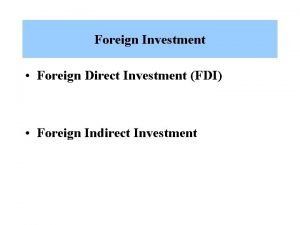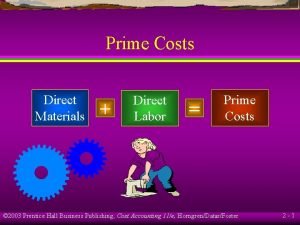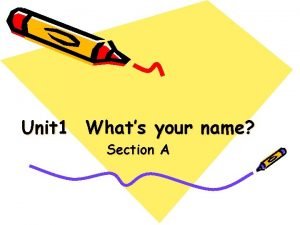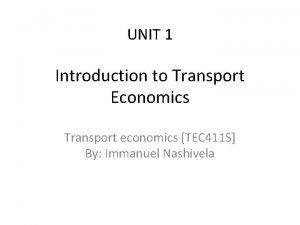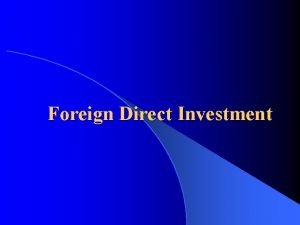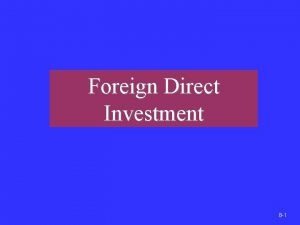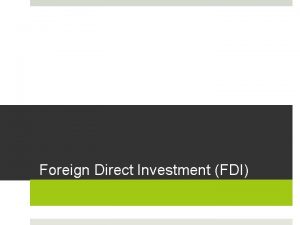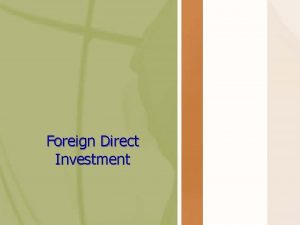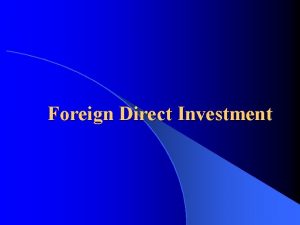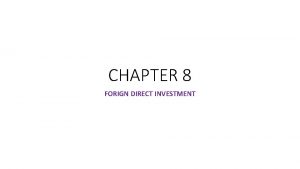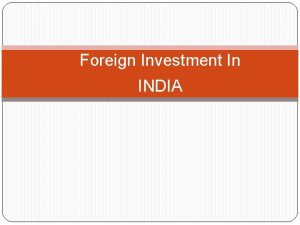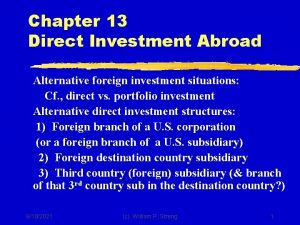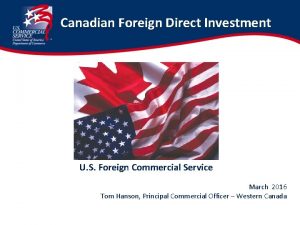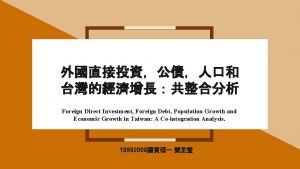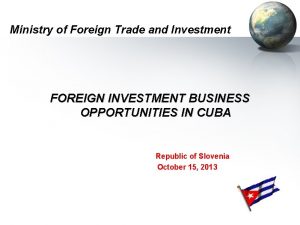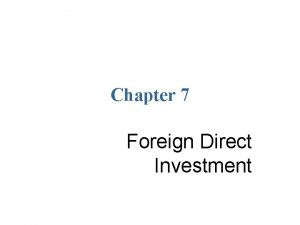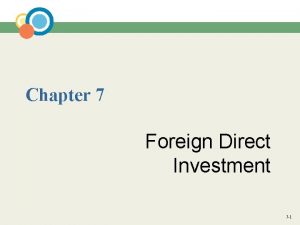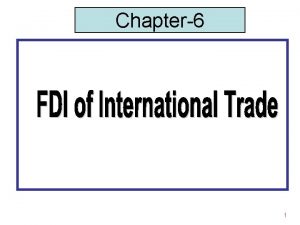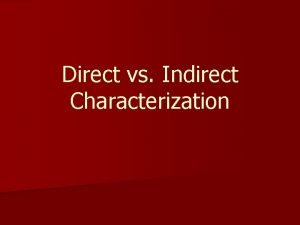UNIT IV Foreign Direct Investment Introduction I foreign



























- Slides: 27

UNIT – IV Foreign Direct Investment

Introduction Ø I foreign direct investment • Invest directly in facilities • Producing or marketing a product • In a foreign country

Forms of FDI: . two forms: ---- Greenfield investment: a new operation ---- acquiring or merging within an existing firm * a minority 10 -49% * majority: 50 -99% * full out-right (completely) stake:

• Definition of 'Green Field Investment' • A form of foreign direct investment where a parent company starts a new venture in a foreign country by constructing new operational facilities from the ground up. In addition to building new facilities, most parent companies also create new longterm jobs in the foreign country by hiring new employees. This is opposite to a brown field investment.

• Definition of 'Brown Field Investment' When a company or government entity purchases or leases existing production facilities to launch a new production activity. This is one strategy used in foreign-direct investment.

FDI: Definition • What is FDI? – FDI occurs when a firm invests directly in facilities to produce and/or market a product in a foreign country – Examples: • Motorola sets up a plant in China to manufacture cell phones • Starbuck purchases an existing UK firm, “British Coffee, ” to sell coffee, tea and desserts in the UK • Volkswagen and two Chinese joint venture partners Shanghai Automotive Industry Corporation (SAIC) and First Automotive Works (FAW) open their newly built gearbox plant in Shanghai "Volkswagen Transmission (Shanghai) Co. Ltd" • Alternatives to FDI – Licensing; Direct Export

FDI: Forms • Forms of FDI – Acquisitions • Purchase an existing company in the foreign country – Greenfield Investments • Set up a new company “from the ground up” in the foreign country – Examples: • Motorola investments money in China and builds a new plant to produce cell phones • Starbucks purchases an existing UK firm “British Coffee” and sells coffee/tea/desserts under the name “Starbucks”

FDI: Forms (II) • Forms of FDI (II) – Wholly Owned Subsidiary • Occurs when the company in the foreign country is entirely controlled/owned by one single company. – Motorola’s company that manufactures cell phones in China – Starbuck’s acquisition that sells coffee/tea/desserts in the UK – Joint Ventures • Occurs when two or more companies together form a new company in the host country • In the international context, usually occurs when one (or more) foreign company and one (or more) local company join to form a new company – Volkswagon + Shanghai Automotive Industry Corporation (SAIC) + First Automotive Works (FAW)

WHAT IS FDI? • Company acquiring or merging with a firm in a different country • A firm creating a ‘Greenfield’ operation in a different country • A firm creating a subsidiary in a different country • Direct investment in foreign-based production or marketing activities with substantial managerial involvement • As a result – The firm has significant control of its foreign operation – Firm can affect managerial decisions of the foreign operation

FDI: Horizontal vs. Vertical • Horizontal vs. Vertical Direct Investment – Horizontal • Investment in the “same” industry as a firm operates in at home – Examples: » Starbucks and its international expansion » Mac. Donald’s and its international expansion – Vertical • Investment in a downstream supplier (backward) or upstream purchaser (forward) as compared to the business that the firm operates in its home country – Examples: » Backward: Volkswagon + SAIC + FAW to produce gearbox (an input to Volkswagon’s home operation) » Forward: Less common. Volkswagon’s acquisitions of dealers in the US (Volkswagon “sold” cars to the dealers in the US. I. e. , Volkswagon sold the output of its home country operations to the US dealers that it acquired)

Why Horizontal FDI? • Transportation Costs • Market Imperfections – Impediments to exporting – Impediments to Sale of Know-How • Strategic Behavior • Product Life Cycle • Location Specific Advantages

• • • HORIZONTAL FDI & FACTORS CONSIDERATION Transportation Costs: High/low value to weight impacts costs. Market Imperfections (Internalization Theory): Factors that inhibit markets from working perfectly. This includes (1) governments impeding the free flow of products between nations, and (2) impediments to the sale of know -how. Strategic Behavior: Concentrated industries (oligopoly) tend to mimic each other’s moves. Where there is multipoint competition, competing firms match each other’s moves to keep the competitor in check. The Product Life Cycle: Suggests that foreign market demand leads to FDI, probably not true and therefore is not a good predictor of FDI. Location-Specific Advantages: Advantages that arise from using resource endowments or assets tied to a particular location (Dunning - eclectic paradigm

VERTICAL FDI • Two forms: – Backward: Providing inputs (raw materials, parts) for a firm’s domestic production processes. – Forward: An industry abroad sells the outputs of the firm’s domestic production processes.

Why Vertical FDI? • Strategic Behavior • Market Imperfections – Impediments to Know-How – Investment in Specialized Assets

WHY IS FDI IMPORTANT? • Firms want a presence in foreign markets • Firms want control over growth of these foreign markets – To gain first mover advantages – To ward off competitors – To determine locations, advertising and other related strategic decisions in the firm’s interest

TRENDS IN FDI • Flow and stock increased in the last 20 years • In spite of decline of trade barriers, FDI has grown more rapidly than world trade because – Businesses fear protectionist pressures – FDI is seen a a way of circumventing trade barriers – Dramatic political and economic changes in many parts of the world – Globalization of the world economy has raised the vision of firms who now see the entire world as their market • The value of FDI slumped almost 60 percent – Slowdown in world economy – Heightened geopolitical uncertainty – Bursting of the stock market bubble in the US

THE REASON FOR GROWTH • The upward trends (both inflows and outflows) is due to several factors such as: a. The increasing number of countries investing and receiving FDI Countries continue to liberalize FDI regime. ii. Enterprises seek to become more international. iii. Many countries depended on FDI as a source of capital -investment. iv. FDI circumvents potential future trade barriers. * v. Dramatic political and economic changes occurring in developing countries* The increasing number of cross border M&A i. b.

WHY DO COMPANIES ENGAGE IN FDI? • Strategic Behavior: Can raise entry barriers or shut out new competitors, or circumvent barriers established by companies already doing business in the foreign country. • Market Imperfections: Need to overcome lack of know-how or the firm must invest in specialized assets whose value depends on inputs provided by a foreign supplier.

FDI WHEN AND WHY? • Transportation costs are high • Market Imperfections (Internalization Theory) – Impediments to the free flow of products between nations – Impediments to the sale of know-how • Follow the lead of a competitor - strategic rivalry • Product Life Cycle - however, does not explain when it is profitable to invest abroad • Location specific advantages (natural resources)

FDI AND RISK • FDI is expensive and risky compared to exporting or licensing: – Costs of establishing facilities. – Problems with doing business in a different culture • Horizontal FDI: FDI in the same industry as the firm operates at home. – Factors to consider: • • • Transportation Costs. Market Imperfections. Following Competitors. Strategic Competitors Location Advantages.

FDI: Benefits to the Host Country Resource Transfer Effects Capital MNE invests capital in foreign markets Technology Research supports that MNEs do transfer technology when they invest in a foreign country Management When MNEs invest and manage in a foreign country, they often transfer management skills to the host country’s workforce Employment Effects MNEs, by investing in foreign countries, can create employment opportunities for the local workforce But: Acquisition vs. Greenfield Investment Balance of Payment Effects Balance of Payment: A country’s balance-of-payment is the difference between the payments to and receipts from other countries FDI can have beneficial and negative effects on a country’s balance of payment. We look at the beneficial effects next Effect on Competition Efficient functioning of markets require adequate level of competition between producers

FDI: Benefits to Host Country’s Balance of Payment Initial Capital Inflow Substitute for Imports When a company invests in a foreign country, it brings capital into that country To the extent that the goods/services produced by the FDI substitute for imported goods/services, there is a positive effect on B-of-P Inflow of payments from export of goods and services To the extent that the goods/services produced by the FDI are exported to another country, there is a positive effect on the host country’s B-of-P

FDI: Costs to Host Countries Adverse Effects on Competition Adverse Effects on Balance of Payments MNEs may have “too much” power and kill off competition After initial inflow of capital, subsequent outflow of capital from the earnings of the FDI may import inputs from abroad National Sovereignty and Autonomy Key decisions that affect the host country’s economy may be made by a foreign parent that has no real commitment to the host country

FDI: Benefits & Costs to Home Country Benefits Stream of income from foreign earnings FDI may import intermediate goods or inputs for production from the home country, creating jobs MNEs may learn skills from exposure to foreign countries Costs Balance of payment: Initial capital outflow (but often set off by future stream of foreign earnings) Current account suffers if FDI is to serve home market from lowcost production location Current account suffers if FDI is a substitute for direct export Employment effects: FDI a substitute for domestic production (e. g. , Etch-A-Sketch)

Government Policy Instruments and FDI: Host Country Policies Encouraging Inward FDI Tax concessions Low-interest loans Grants Subsidies Restricting Inward FDI Ownership restraints Exclusion from certain industries Why do so? To protect national interest (defense, etc) To facilitate resource-transfer Performance requirements Local content, exports, technology transfer, and local participation in top management

Government Policy Instruments and FDI: Home Country Policies Encouraging Outward FDI Insurance programs to cover major types of foreign investment risks Special funds or banks to make government loans Political influence to persuade host countries to relax restrictions on inbound FDI Restricting Outward FDI Limit capital outflows Manipulate tax rules to encourage investment at home Outright prohibition from investing in certain countries

Decision Framework for FDI Are transportation costs high? Ye s Is know-how easy to license? No Import Barriers? No Ye s No FDI Yes FDI No License Ye s Tight control over foreign ops required? No Is know-how valuable and is protection possible? Export
 Starbucks foreign direct investment case study
Starbucks foreign direct investment case study Foreign direct investment advantages and disadvantages
Foreign direct investment advantages and disadvantages Foreign direct investment advantages and disadvantages
Foreign direct investment advantages and disadvantages Foreign direct investment advantages and disadvantages
Foreign direct investment advantages and disadvantages Foreign direct investment in malay
Foreign direct investment in malay Afnan hossain
Afnan hossain Fixed investment and inventory investment
Fixed investment and inventory investment Foreign investment in finland
Foreign investment in finland Eclectic theory
Eclectic theory Too foreign for home
Too foreign for home Direct investment and collaborative strategies
Direct investment and collaborative strategies Homestrings
Homestrings Stages of international marketing
Stages of international marketing Infrequent foreign marketing example
Infrequent foreign marketing example Unit 6 review questions
Unit 6 review questions Strategic hospitality technology investment
Strategic hospitality technology investment Cisi introduction to securities and investment
Cisi introduction to securities and investment What is strategic investment unit
What is strategic investment unit Unit 4 lesson 10 american foreign policy
Unit 4 lesson 10 american foreign policy Direct material + direct labour
Direct material + direct labour Direct method teachers role
Direct method teachers role Constant of proportionality example
Constant of proportionality example Introduction paragraph format
Introduction paragraph format Difference between primitive and non primitive data types
Difference between primitive and non primitive data types Unit 1 introduction to accounting
Unit 1 introduction to accounting Unit 1 introduction names and terms to know
Unit 1 introduction names and terms to know Unit 1 introduction to logistics
Unit 1 introduction to logistics Unit 1 introduction to accounting
Unit 1 introduction to accounting
